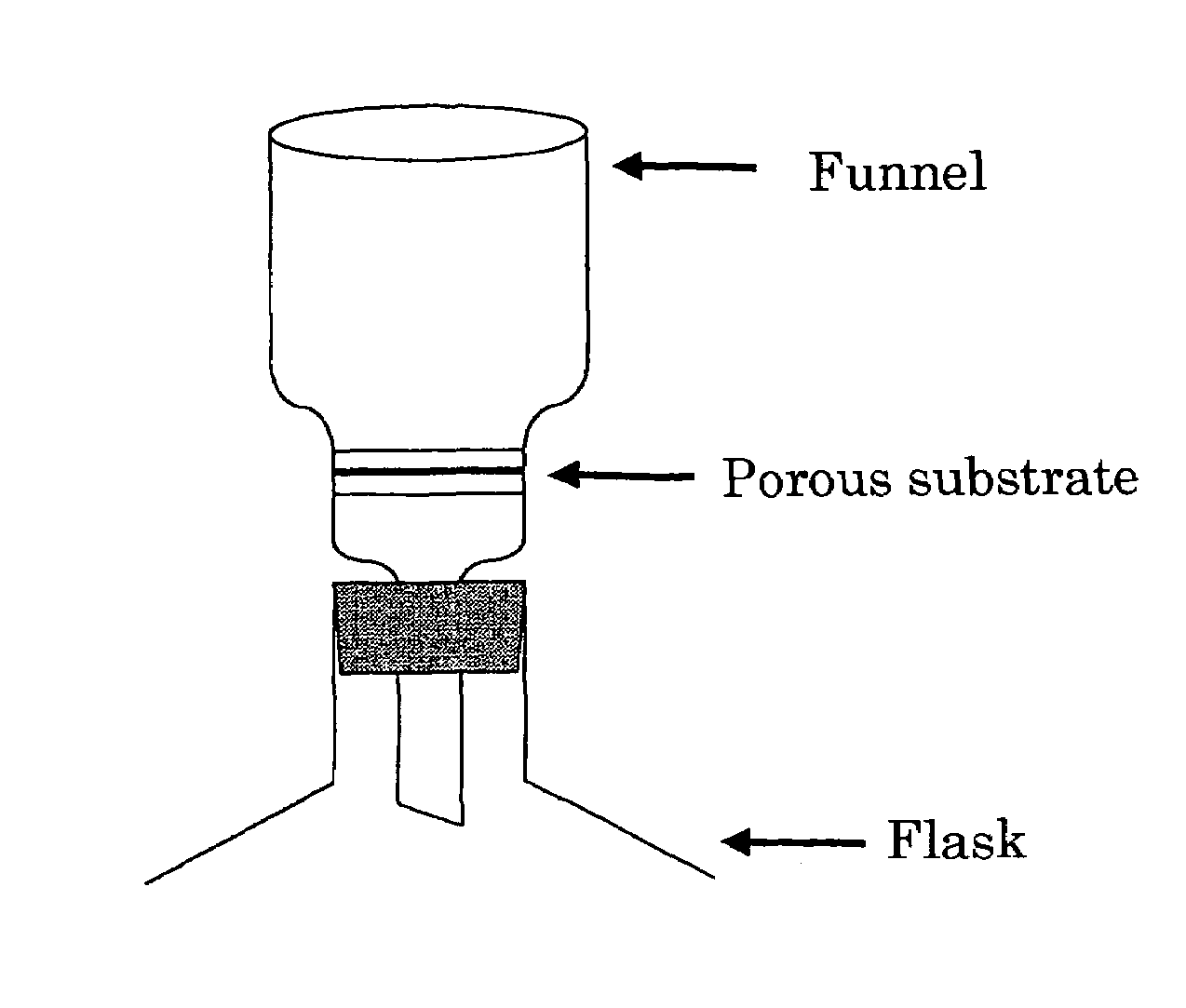Method for producing nanotube material and nanotube material
- Summary
- Abstract
- Description
- Claims
- Application Information
AI Technical Summary
Benefits of technology
Problems solved by technology
Method used
Image
Examples
example 1
[0092]A common filter paper (manufactured by Advantec) was attached to a vacuum filtration apparatus shown in FIG. 1, washed by vacuum filtration of 40 ml of ethanol, prior to the use and dried by air flow. 10 ml of a titanium butoxide (Ti(OBu)4) solution (100-mM 1:1 toluene / ethanol solution) was slowly filtered over 3 minutes, the filter paper was washed by vacuum filtration of 20 ml of ethanol twice, titanium butoxide adsorbed to the filter paper was hydrolyzed and condensed by vacuum filtration of 20 ml of deionized water, and the resultant filter paper was dried by air flow. Each cellulose fiber in the filter paper was coated with a titania gel thin film in this manner. Then, the steps of filtration, washing, hydrolyzation, and drying were repeated 20 times, the resultant filter paper / titania composite was treated at 450° C. for 6 hours at a heating rate of 1° C. / minute, and the filter paper used as template was burned and removed. As a result, a self-supportable titania nanotub...
example 2
[0097]A titania nanotube material was produced in the same manner as Example 1 except for using a cotton cloth instead of the filter paper of Example 1. The resultant cotton cloth / titania composite was subjected to a burning treatment to obtain a self-supportable titania nanotube material having the same shape as the original cotton cloth. This is a cloth-shaped nanotube material, which may be referred to as “titania cloth”.
[0098]A scanning electron microscope image of the obtained titania nanotube material is shown in FIG. 3. The internal structure of the titania cloth was precisely reproduced in the titania. It was clear that the titania nanotube material had a uniform outer diameter of several tens nanometers, and the nanotubes were aggregated into a macro body.
example 3
[0099]A titania nanotube material was produced in the same manner as Example 1 except for using a common absent cotton yarn as a template instead of the filter paper of Example 1. The resultant cotton yarn / titania composite was subjected to a burning treatment to obtain a self-supportable titania nanotube material. The titania nanotube material had the same size as the cotton yarn template, and thus may be referred to as “titania yarn”.
[0100]A scanning electron microscope image of the helical titania nanotube arrangement is shown in FIG. 4. The internal structure of the cotton yarn was carved in the titania layer, and the titania nanotube arrangement was clearly observed. The titania yarn had an outer diameter of several tens to several hundreds nanometers, and the nanotubes were aggregated into a macro fiber. The titania yarn had a length of several hundreds micrometers. As shown in FIG. 4, a helical nanotube arrangement, which was formed due to twisting of an aggregate of cellulos...
PUM
 Login to View More
Login to View More Abstract
Description
Claims
Application Information
 Login to View More
Login to View More - R&D
- Intellectual Property
- Life Sciences
- Materials
- Tech Scout
- Unparalleled Data Quality
- Higher Quality Content
- 60% Fewer Hallucinations
Browse by: Latest US Patents, China's latest patents, Technical Efficacy Thesaurus, Application Domain, Technology Topic, Popular Technical Reports.
© 2025 PatSnap. All rights reserved.Legal|Privacy policy|Modern Slavery Act Transparency Statement|Sitemap|About US| Contact US: help@patsnap.com



